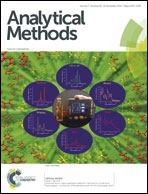Quantification of Zn(ii) using a label-free sensor based on graphene oxide and G-quadruplex
Abstract
By employing two-dimensional and water-soluble graphene oxide (GO), a turn-on sensor was developed for the label-free detection of Zn2+ based on Zn2+-induced G-quadruplex (G4) formation. Indicated using the G4-binding ligand thiazole orange (TO), the enhanced fluorescent signal could be generated only when the guanine-rich DNA was excluded from the surface of GO due to the formation of a G4 induced by Zn2+. The results have shown that the method can be utilized for the detection of Zn2+ in a linear range from 0–30 μM with a detection limit of 0.71 μM. The real sample testing conducted in serum samples demonstrated its practical potential in biological analysis.


 Please wait while we load your content...
Please wait while we load your content...